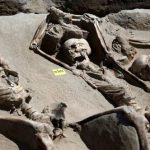 Mysteries
Mysteries  Mysteries
Mysteries  History
History 10 Surprising Stories About the Texas Rangers
 Humans
Humans 10 Philosophers Who Were Driven Mad by Their Own Theories
 Miscellaneous
Miscellaneous 10 Video-Game-Worthy Weapons and Armors from History
 Weird Stuff
Weird Stuff 10 Psychics Who Accurately Predicted Wartime Events
 The Arts
The Arts 10 Pieces of Art Inspired by a Broken Heart
 Health
Health 10 Science Fiction-Sounding New Medical Treatments
 History
History 10 Surprising Facts About the Father of Submarine Warfare
 Space
Space Ten Astonishing New Insights into Alien Worlds
 Weird Stuff
Weird Stuff 10 Bizarre Summer Solstice Rituals Still Practiced Today
 Mysteries
Mysteries Top 10 Haunting Facts About the Ghost Ship MV Alta
 History
History 10 Surprising Stories About the Texas Rangers
 Humans
Humans 10 Philosophers Who Were Driven Mad by Their Own Theories
Who's Behind Listverse?

Jamie Frater
Head Editor
Jamie founded Listverse due to an insatiable desire to share fascinating, obscure, and bizarre facts. He has been a guest speaker on numerous national radio and television stations and is a five time published author.
More About Us Miscellaneous
Miscellaneous 10 Video-Game-Worthy Weapons and Armors from History
 Weird Stuff
Weird Stuff 10 Psychics Who Accurately Predicted Wartime Events
 The Arts
The Arts 10 Pieces of Art Inspired by a Broken Heart
 Health
Health 10 Science Fiction-Sounding New Medical Treatments
 History
History 10 Surprising Facts About the Father of Submarine Warfare
 Space
Space Ten Astonishing New Insights into Alien Worlds
 Weird Stuff
Weird Stuff 10 Bizarre Summer Solstice Rituals Still Practiced Today
Top Ten Unique Facts about Burial Practices in New Orleans
New Orleans has a reputation for being a particularly dark city. Its battles with yellow fever, the high crime rate, and being in the direct line of many hurricanes have led it to accumulate one of the highest death rates in United States history.
Many know of the above-ground tombs that appear throughout the city as monuments to its deceased. But what many do not know is how these unique tombs operate and the history behind them. How did they get there? Why are they still being used today, and in what fashion? Not only are the tombs themselves fascinating, but the practices, traditions, and customs that surround them have been intriguing visitors to the city for generations.
Below is a concise list of how these tombs work, their origins, and the cultural traditions that make them so unique.
Related: 10 Strangely Specific Burial Requests
10 Below Ground Burials Didn’t Work
Around 15 New Orleans cemeteries contain tombs built above ground. The main reason for such burials has to do with the city’s unique location.
New Orleans was settled in 1718 on a raised river bank beside the Mississippi River. The Mississippi would flood annually, depositing the sediment it collected from farther up the river. These silt deposits accumulated on the riverbanks and formed natural levees or raised land embankments. New Orleans sits on top of one of these well-drained levees.
Unfortunately, the first residents soon discovered the error in trying to bury their dead in this raised riverbank. When flood season came, the water table would rise beneath the coffins, pushing them like corks out of the ground. They would swiftly break apart, and human remains would wash away—sometimes through the city streets!
Of course, many of the early residents of the city were also from France and Spain, a location that already used above-ground burials. So it might not have been all about the city lying below sea level.[1]
9 Yellow Fever Created Many of the Cemeteries
Yellow fever epidemics struck the United States repeatedly in the 18th and 19th centuries. The disease was not indigenous; epidemics were imported by ship from the Caribbean. Before 1822, yellow fever attacked cities as far north as Boston, but after 1822, it was restricted to the southern regions of the States. Port cities were the primary targets, but the disease occasionally spread up the Mississippi River system in the 1800s. New Orleans, Mobile, Savannah, and Charleston were major targets.
Records of deaths due to yellow fever only began in 1817 and stopped in 1905 when a vaccine was invented. During this period, over 41,000 people died of the disease. Many of the cemeteries in the city were built to accommodate the massive number of deaths caused by this mosquito-bred disease. St. Louis Cemetery #2 was consecrated in 1823 for this very reason. In 1853, St. Louis Cemetery #3 was consecrated after over 8,000 people died of yellow fever in three months![2]
8 Below Ground Burials Were Once Illegal
In 1803, the city legally declared that all burials had to occur above ground. This was to stop bodies from floating away and spreading more disease—hopefully, for the general standard of living as well. At the time, people believed yellow fever was spread from Miasma or “bad air” that traveled out of the corpses.
However, below-ground burials in New Orleans are now very much legal and common. A pumping system invented in 1914 by a man named Albert Wood helped drain the city, allowing below-ground burials to be possible for those who religiously felt obliged to do so. Jewish and Protestant cemeteries are commonly found throughout the city. The Catholic Church owns 13 cemeteries out of the 43 that exist in the city, and as such, many of the above-ground tombs were owned by Roman Catholic families. Protestants adopted what they called the “Latin” form of burial out of necessity.
These pumps also helped curb the mosquito population as flood waters no longer sat stagnant after a storm. Yellow fever had been eliminated with a vaccine at this time, but malaria was still common. Cleaner drinking water was also provided due to these pumps, prolonging the lives of New Orleanians across the city. Wood became so successful he built pumps across the world in Amsterdam, China, and India. They are still used in New Orleans with mixed results, as they have been poorly maintained.[3]
7 An Old Cemetery Lies Below the French Quarter
From 1723 to 1800, the city buried its dead outside city limits, the French Quarter being about half the size of what it is today. The St. Peter Cemetery was the first official cemetery of the city. The Spanish gained control of the colony of Louisiana in 1762 and, by the 1780s, decided a new cemetery was needed for the growing city and its quickly dying population.
The St. Peter Street Cemetery was opened in the 1700s outside the main part of the city when the earlier burial ground was deemed harmful to the levee (burials were initially closer to the Mississippi River). They had to find a better place for the overwhelming amount of dead piling up on the streets and in the cemetery. During heavy rains, the bodies floated atop the consecrated plot, creating a bog full of the dead. Many denizens of the city brought dead farm animals and even their own waste into the mix, and the land became more of a cesspool than a cemetery. Around 1800, the original Catholic cemetery was closed and paved over before buildings were built atop it. The old cemetery was then quickly forgotten.
Caskets are often discovered to this day. In 2011, a man named Vincent Marcello unearthed fifteen coffins while building a pool for his apartment complex. This pool is known locally as the “pool of souls” today. Caskets weighing 600–800 pounds (272–363 kilograms) each were found very tightly packed next to each, showcasing the disparity of the city at the time.
Astonishingly, crew members discovered all the bodies uncovered were of African or Native American descent. Proof of the mixed burials in the old city and testament to the multi-cultural history of New Orleans. It is believed between 8,000 and 12,000 people now lay underneath this section of the French Quarter between N. Rampart, St. Peter, St. Ann, and Dauphine Streets.[4]
6 Above-Ground Tombs in New Orleans Hold Multiple People
Above-ground tombs are seen as New Orleanian inventions by many Americans. However, they were quite popular in many French and Spanish cities prior to their use in the States and were introduced by the Spanish during their colonial rule. Most of the tombs seen around New Orleans are owned by individual families and can hold a vast amount of people. This is possible because they operate as slow-burning furnaces.
A body is placed on top of a shelf in the tomb for a “year and a day” to properly execute the cycle of “from ashes to ashes and dust to dust” of Judeo-Christian doctrine. After this period, the body is either pushed to the back of the tomb or removed and placed in the bottom section. Due to the high humidity and heat of the area, the bodies are slowly cremated over the course of fifty to sixty years. Multiple generations can be held in each individual tomb, sometimes totaling up to 60 people or more.[5]
5 Bodies Are Often Placed Inside Walls
Bodies are even inside the walls of the cemeteries in New Orleans. As space became more limited, it became a cheaper and space-efficient way to prevent corpses from floating away. Often these types of tombs were used during the heaviest years of the various yellow fever epidemics. They were also used as “rental tombs.”
If two family members died within the same traditional year and a day period, which was common during a yellow fever epidemic, the second to die would be placed inside a wall vault. The year-and-a-day period would occur, and the body would then be reinterred into the lower vault of the family tomb. Many of these wall vaults are reused by families and can sometimes hold up to ten people each inside of them![6]
4 Above Ground Tombs Originate from Roman Times
Wall vaults were loosely based on Roman burial sites known as Columnbarias. While these were generally used to hold the actual cremated remains of Romans, rather than acting as full-on burial vaults as they do in New Orleans, they have a similar structure. Columnbarias were built below ground in chambers carved out of tufa rock. Beautifully designed, they were meant to hold thousands of human remains and lifted to the ceilings of these Roman burial chambers. The wall vaults of New Orleans lay above ground and are not as ornate as their roman counterparts but are nevertheless a unique feat of human ingenuity.[7]
3 Society Tombs Took Care of People in Life & Death
Some minority groups within a larger society did not have the means to afford their own tombs. Eventually, organizations would form called Benevolent Societies. These groups provided medical services, community events, and a final resting place in the afterlife. The first was formed by groups of newly freed African peoples in 1783 and named the Perseverance and Mutual Aid Association. They were later commonly organized by groups of immigrants, religious orders, and the less affluent French and Spanish of the city.
Once common around the western world, they are still active and alive in New Orleans. The Italian Benevolent Society, located in St. Louis Cemetery #1, is one of the most stunning and well known. It was used, without the consent of the archdiocese, in the filming of the 1969 hippie cult classic Easy Rider. This would be the last Hollywood film to be shot in the cemetery, and only one of two to have ever used the historic cemetery as a backdrop. The 1965 film Cincinnati Kid came first.
The scene in question is a surreal mishmash of sexual promiscuity, backdropped by the classical tombs of St. Louis—all shot guerrilla style. Peter Fonda, the producer and star of the film, ends up in the arms of the statue lining the front facade of the Italian Benevolent Society tomb, demanding of it, “why did you leave me?” and “how could you do this to me?” while bawling uncontrollably. It turns out he and his co-stars had taken LSD before filming the scene.
Soon after the film was released, the archdiocese passed a law banning all filming except for educational or religious purposes. Today tourists are not allowed to take videos inside St. Louis Cemetery #1.[8]
2 The Tombs Are Cleaned and Maintained by Families
In the early days of the Catholic Church, saints were traditionally honored on their own day, but with the growing number of saints, this soon became a problem. In the seventh century, Pope Boniface IV officially established All Saints’ Day in order to honor all the saints at one time. History records an earlier sacred day before Boniface’s time, but it wasn’t widely observed. Originally, Christians observed All Saints’ Day on May 13. But in the eighth century, Pope Gregory III moved it to November 1.
The first All Saints’ Day in New Orleans occurred in 1742 as the old St. Peter Cemetery was celebrating a rededication. Today, family members come to their tombs to clean them and leave gifts for their deceased ancestors. These gifts include flowers, photographs, food stuffs, and even alcohol. The holiday is practiced in most Catholic countries but is not seen in such brilliance anywhere around the United States as it is in New Orleans.[9]
1 Funeral Procession Include a Musical Element
Second Lines, sometimes referred to as Jazz Funerals, are a cultural phenomenon originating in New Orleans and found nowhere else in the United States. One of the many services provided to members of the aforementioned benevolent societies was a funeral procession with a somber musical procession following behind.
In 1875, the “Société d’Economie et d’Assistance Mutuelle,” a black benevolent society, held a meeting and deemed the official music to be “brass band” music. After the initial dirge, it became common for bands to play happy, fun, upbeat music, and by 1883 these processions were being used for the society’s annual parade. Today, these parades are used for both funeral processions and general celebrations across the city.
Much of New Orleans’ music, dress, and parade culture originated from these early processions. They are a common occurrence in everyday life in the Crescent City. Death and life are closely connected in New Orleans, their dead incomparably revered and celebrated—forever from ashes to ashes and dust to dust.[10]








